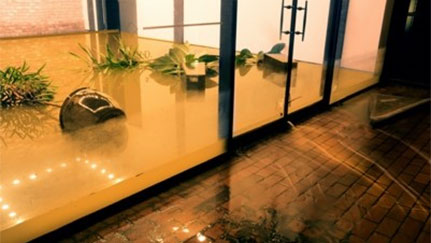How water monitoring systems can help your construction project

How sensors and technology can protect your construction project
On a single construction jobsite, there could be hundreds or even thousands of pipe fittings being installed. With a constant flow of contractors working on or around water pipes and sites often left unoccupied or exposed to weather for extended periods, the risk of water damage is significant. Nationwide data reveals that about one-third of all general liability losses for contractors stem from water-related causes.1 Implementing technology, such as smart leak detection, is an important step in mitigating these water losses.
What is a smart water leak detection system?
Water leak detection systems are made up of a software platform, various sensors, and a communication network. The system is designed to work around the clock monitoring and detecting water problems as soon as they happen. When a problem is detected, alerts are sent to key contacts, and if enabled, remote shutoffs can be activated. Explore details on water leak detection systems below.
The software platform:
Software platforms vary in sophistication and can engage a single sensor or a host of water temperature, humidity sensors and shutoffs. Platforms allow the user to receive emergency water leak alerts via phone calls, shut-off valves, and utilize artificial intelligence to identify unusual patterns and generate reports. Most platforms are available as a mobile or desktop app. A key consideration with any software platform is having the right people receive the leak notifications. Users should be trained ahead of time on how to respond to water emergencies. It is also a best practice to have multiple people receive notifications and redundancies built into your response plan.
Remote water shut-off valves:
Turning on the water for the first time at a large construction project can be a high-risk endeavor. Every moment the water is on at the building is an opportunity for a water damage disaster to strike. Remote water shut-off valves allow users to turn off water flow by tapping a button on their phone. Valves are generally available in sizes ¾" to 8” or greater. They can also be configured to shut off water automatically when combined with point-of-leak sensors. These shutoffs do have the capability to be reset when triggered.
Water leak sensors:
Water leaks can be detected in two ways: either water touches a leak sensor, or the water flow pattern at a building is flagged as abnormal or outside of parameters by the software platform. Below are details on the types of water leak sensors that are currently available:
Point of leak sensors
Battery-operated water leak detectors are placed near water systems, plumbing fixtures, water using appliances, critical or high value equipment, electrical systems, mechanical systems (elevator rooms/shafts), etc. When the sensors get wet, they notify designated users of the exact location of the leak so that it can be resolved before significant damage occurs.
Water flow sensors
Water flow sensors monitor water volume flowing through pre-existing water meters and send the data to the platform for analysis. Problems, such as sudden spikes in water use, continuous leaks, water use above a user-defined threshold (e.g., 0 gal/min or certain hours of day), trigger notifications. These sensors can be ideal for pre-construction or partially occupied phases of construction. Detecting water use abnormalities can be enhanced by the AI analytics of the platform if available.
Temperature & humidity sensors
Temperature extremes can also be a costly cause of water damage. Humidity levels that are too high promote mold growth. Temperatures that fall below 40˚ F can subject your system to freezing and bursting pipes.
Communication hub
Water leak detection systems that rely on standalone, reliable cellular networks are the preferred choice for preventing damage because they continue to operate in power outages and do not require an existing WiFi or wireless network at the jobsite.
Key take-aways
Smart water leak detection systems are essential for protecting construction projects from water-related damage. These systems, comprising software platforms, sensors, and communication networks, provide real-time monitoring and alerts to prevent costly water damage. By integrating remote water shut-off valves, point-of-leak sensors, water flow sensors, and temperature & humidity sensors, construction firms can significantly reduce the risk of water damage. Implementing these technologies ensures that potential issues are detected and addressed promptly, safeguarding the project and minimizing financial losses.
Action: Setting up a plan
Assemble key stakeholders and assess the jobsite water damage exposures. Design a monitoring solution that addresses your needs. Implement and test your monitoring solution to ensure performance meets your expectations. Monitor your project for water damage hazards. Ensure multiple contacts are configured to receive notifications.
Setup a plan to respond to a water damage emergency. See Nationwide’s Water Damage Response Planner (PDF).
More resources recommended for you
Supplement this article: Water Damage Response Planner
More on this topic: Construction Water Mitigation Program
Construction resources: Construction Risk Management Resources
1Nationwide construction loss analysis 2024.
